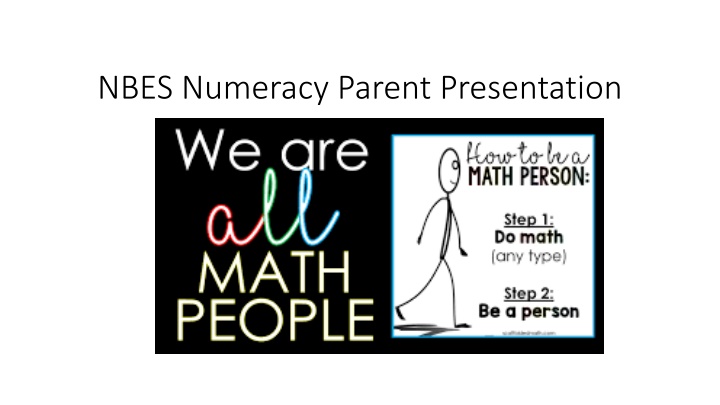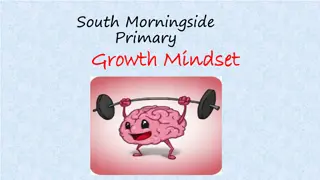Inspiring Insights on Numeracy, Growth Mindset, and the Power of Struggle
Explore the fascinating world of numeracy through presentations on fostering belonging, the attributes of a supportive community, the importance of grit and growth mindset, and the positive impact of struggle on learning. Discover how attitudes of parents and teachers influence math success and learn strategies to support mathematical development. Dive into the neuroscience behind productive struggle and embrace challenges as pathways to success.
Download Presentation

Please find below an Image/Link to download the presentation.
The content on the website is provided AS IS for your information and personal use only. It may not be sold, licensed, or shared on other websites without obtaining consent from the author.If you encounter any issues during the download, it is possible that the publisher has removed the file from their server.
You are allowed to download the files provided on this website for personal or commercial use, subject to the condition that they are used lawfully. All files are the property of their respective owners.
The content on the website is provided AS IS for your information and personal use only. It may not be sold, licensed, or shared on other websites without obtaining consent from the author.
E N D
Presentation Transcript
NBES Attribute Wheel Focus on Belonging How do we foster belonging? Safe Respected Valued Supported Inclusive Community
GRIT = perseverance + passion Angela Duckworth Psychologist Who is successful here and why? Perseverance and passion are most important indicators of success TED Talks: Sylvia Duckworth GRIT: The Power of Passion and Perseverance
Growth Mindset = intelligence can be developed with effort and experience Carol Dweck - Psychologist When one has a growth mindset, one embraces challenge and sees effort and perseverance as the path to success. The power of yet ! TED Talk: Carol Dweck: The Power of Believing That You Can Improve
The Positive Power of Struggle Why Struggle is Essential for Our Brain and Our Lives Neuroscience Behind Productive Struggle Struggle is critical to mastery Those that have struggled the most are the highest achievers Mistakes are good for our brain Expected, inspected, respected If you are only doing what you already know how to do, you are not learning or growing your brain hard, fun That feeling of hard is the feeling of your brain developing, strengthening and growing . Self-regulation strategies for when one is feeling frustrated, tired, or defeated develop stamina
Attitude of Parents and Teachers Matter Numeracy is unique in our curriculum: Poisoned relationship I hate math I m not a math person This is not the way I was taught The attitude of parents/teachers impacts success of learner Teachers/parents teach how they learned The best support is encouraging a positive growth mindset and to play with numbers! Dr. Jo Boaler YouCubed Parents' Beliefs About Math Change Their Children's Achievement 6 Ways to Support Your Child's Mathematical Development So, undoing and rebuilding our relationship is imperative
What is Math? What one word comes to mind? "Math is" video from Global Math Project What Math is not: Human calculator Fast speed pressure, timed tests One way to solve One right answer Rules and steps Memorization students who took a memorization approach to mathematics were the lowest-achieving students in every country (Boaler 2020) What Math is: Rich dialogue Collaboration Curiosity Perseverance Problem-solving Creative and flexible Purposeful and contextual
B.C. Curriculum Numeracy spiral BIG Ideas across the grades Spiral Same 5 areas Revisit and build (developmental readiness) Goals of our Curriculum Develop curricular competencies Very similar across all areas in curriculum If our goal is to develop deep we have to DO deep Curricular Competencies across the grades Same 4 big skill sets Progression: Concrete Pictorial Symbolic Manipulatives, pictures, models expected for all
Some KEY WORDS from the curriculum: Concrete materials Mental math strategies Flexible Estimate reasonably Multiple strategies Model and draw Explain and justify Make connections What kind of tasks and learning experiences foster this? 7 x 6 = 42 = X + Y + Z = 42
5 x 18 How do you see the problem? The power of visualizing! 2/5 brain pathways are visual Quantity finger perception critical for number sense Connect different areas of brain Visual representation + symbolic Visual tasks are engaging! students are inspired by the creativity that is possible when mathematics is visual Boaler,2020
Number Talks A powerful way to surface and catch strategies to build upon Strategies are caught, not taught! A strong sense of number is imperative to developing strategies The number and kind of experiences a person has impacts strategy development tools in your toolkit 12 x 18
The power of models Area model a model with legs across the grades Promoting Models Mash Up Math! Area Models Explained
Goals: Foster positive attitude and growth mindset see math as creative and collaborative and a place for success for all Develop structures, routines, practices that foster learning communities and belonging Number Talks Alternatives to worksheets Mathematical Discourse Rich tasks Math Passports Develop learners with a deep conceptual understanding and with lots of tools in their toolkit ! Develop NBES Grit Problem- solving, Collaboration, Curiosity, Regulation through the kinds of learning opportunities students are immersed in























